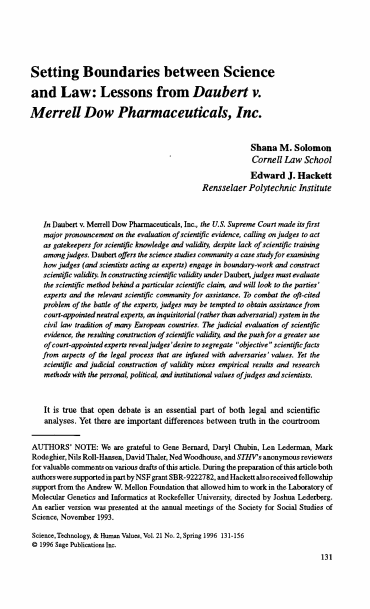
"In Daubert v. Merrell Dow Pharmaceuticals, Inc., the U.S. Supreme Court made its first major pronouncement on the evaluation of scientific evidence, calling on judges to act as gatekeepers for scientific knowledge and validity, despite lack of scientific training among judges. Daubert offers the science studies community a case study for examining how judges (and scientists acting as experts) engage in boundary-work and construct scientific validity. In constructing scientific validity under Daubert, judges must evaluate the scientific method behind a particular scientific claim, and will look to the parties’ experts and the relevant scientific community for assistance. To combat the oft-cited problem of the battle of the experts, judges may be tempted to obtain assistance from court-appointed neutral experts, an inquisitorial (rather than adversarial) system in the civil law tradition of many European countries. The judicial evaluation of scientific evidence, the resulting construction of scientific validity, and the push for a greater use of court-appointed experts reveal judges’ desire to segregate "objective" scientific facts from aspects of the legal process that are infused with adversaries’ values. Yet the scientific and judicial construction of validity mixes empirical results and research methods with the personal, political, and institutional values of judges and scientists."
Shana M. Solomon and Edward J. Hackett, "1996. Solomon and Hackett. "Setting Boundaries between Science and Law: Lessons from Daubert v. Merrell Dow Pharmaceuticals, Inc."", contributed by Maggie Woodruff, STS Infrastructures, Platform for Experimental Collaborative Ethnography, last modified 29 May 2018, accessed 4 April 2025. https://stsinfrastructures.org/content/1996-solomon-and-hackett-setting-boundaries-between-science-and-law-lessons-daubert-v
Critical Commentary
This 1996 article by Shana M. Solomon and Edward J. Hackett relates the importance of Daubert v. Merrell Dow Pharmaceuticals, Inc. in the evaluation of scientific evidence.